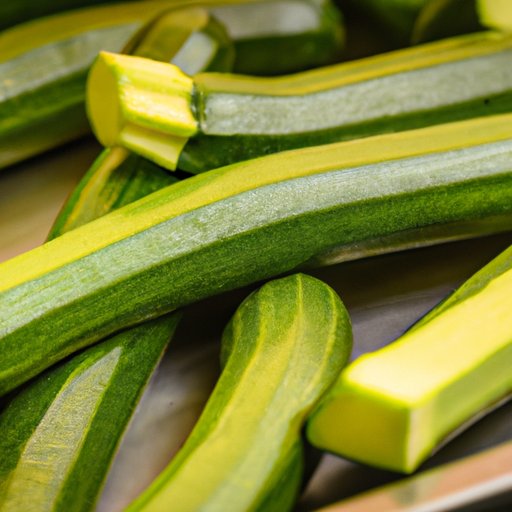Can You Freeze Zucchini?
Zucchini is a popular summer squash plant that is easy to grow in home gardens. It is a versatile vegetable that can be used in many dishes, including salads, pasta, and stir-fry. However, if you have a prolific zucchini plant, you may be wondering how to preserve excess zucchini. One preservation method is freezing. In this article, we explore whether you can freeze zucchini, the pros and cons of freezing, beginner’s guide to freezing, how to maintain its nutritional value, creative recipe ideas, expert advice on avoiding common mistakes, and the importance of reducing food waste through preservation methods.
The Pros and Cons of Freezing Zucchini
Freezing zucchini has advantages and disadvantages.
Advantages of freezing zucchini:
First, freezing extends the shelf life of zucchini for up to 8 months. It means you can enjoy it when it is out of season. Second, it is a convenient way to preserve excess zucchini. Freezing is an easy and accessible preservation method that requires only a few steps. Finally, prepared zucchini can be easily incorporated into cooked or baked dishes, eliminating the need for prep work.
Disadvantages of freezing zucchini:
The potential loss of flavor and texture changes may occur in frozen zucchini. Freezing can cause zucchini to become mushy when it is thawed. Freezing also reduces the nutritional value of zucchini to some extent.
A Beginner’s Guide to Freezing Zucchini
Here are some helpful tips for beginners on how to freeze zucchini:
Tips for selecting the best zucchinis for freezing:
The best zucchini for freezing should be young and tender, with no blemishes, and free from insects. Overly mature zucchinis may have a tougher texture and seeds that reduce the quality of the end product.
Preparation steps for freezing zucchinis:
1. Wash zucchini thoroughly.
2. Chop zucchini into desired sizes. Slicing it into discs or dicing into small cubes are good options.
3. Blanch zucchini by boiling it for about 3 minutes. It is recommended to blanch zucchini to minimize enzymatic reactions that can cause flavor loss and maintain its texture. Blanching also helps to preserve the vegetable’s color.
4. Remove from boiling water and plunge it into ice-cold water to stop the cooking process.
5. Drain the zucchini and pat it dry thoroughly.
6. Freeze in small portions to prevent it from sticking together and being difficult to thaw.
Storage recommendations and how to thaw frozen zucchini:
Zucchini can be stored in freezer bags or containers. Squeeze out as much air as possible to avoid freezer burn. Label the package with the date of freezing. Frozen zucchini should be thawed in the refrigerator overnight. It should not be thawed on the kitchen counter because it can encourage bacterial growth or cause the zucchini to rot.
How to Freeze Zucchini to Preserve Its Nutritional Value
Zucchini is a vegetable that is rich in vitamins, minerals, and fiber. Here are tips for preserving the zucchini’s nutritional value during the freezing process:
1. Use zucchini within 24 hours of harvesting or buying. The longer the zucchini sits, the more nutrients it loses.
2. Blanch zucchini to lessen the number of enzymes that destroy nutrients. Blanching also maintains its nutritive value and bright color.
3. Avoid adding salt, oils, and other seasonings, as they can impact the nutritional integrity of zucchini.
4. Freeze zucchini within two hours of blanching to retain the maximum amount of nutritional content.
Common mistakes to avoid when freezing zucchini:
– Freezing raw zucchini: It can cause the vegetable to spoil quicker once it’s thawed, leading to bacterial growth.
– Skipping blanching: Blanching neutralizes the enzyme activity, preserving the vegetable’s texture, color, and flavor.
– Using larger portions for freezing: Freezing zucchini in large quantities can cause it to lose its texture when thawed.
10 Creative Ways to Use Frozen Zucchini
Here are ten creative recipe ideas to use frozen zucchini:
1. Zucchini Bread: Use frozen grated zucchini in place of fresh zucchini in the recipe for a delicious and moist bread.
2. Zucchini Fritters: Mix thawed shredded zucchini and egg together and fry on a skillet for a crispy snack.
3. Zucchini Lasagna: Substitute frozen zucchini for lasagna noodles.
4. Zucchini Soup: Blend thawed zucchini with broth, herbs, and spices for a creamy soup.
5. Zucchini Chips: Bread and bake thawed zucchini slices for a healthy snack.
6. Zucchini Quiche: Incorporate thawed, diced zucchini into the egg mixture for a hearty breakfast.
7. Zucchini Boats: Scoop out frozen zucchini halves and fill with cooked chicken, cheese, and spices.
8. Zucchini Noodles: Use a spiralizer to make zucchini noodles for a healthy pasta substitute.
9. Zucchini Enchiladas: Substitute frozen zucchini for tortillas and layer with cheese, veggies, and sauce.
10. Zucchini Brownies: Add thawed zucchini to your favorite brownie recipe for added nutrients and moisture.
Expert Advice: Avoiding Common Zucchini Freezing Mistakes
We spoke to Peggy, a food preservation expert, on tips for avoiding common zucchini freezing mistakes:
“The most important thing to note is that blanching is essential. Don’t skip that step. When blanching, make sure that the ice water you “shock” the vegetables in is very cold to stop the cooking process. Also, be sure to label the zucchini accurately once it is stored in the freezer. So often forgotten in the freezer, and it’s difficult to determine vegetables’ age without the date.”
Conclusion
Freezing zucchini is an excellent way to preserve excess zucchini from your garden or the abundance from the farmer’s market. There are many creative ways to use frozen zucchini, including using it in soups, bread, and fritters. However, freezing zucchini requires blanching and smaller portions to maintain its texture, color, and nutrients. It’s worth remembering that freezing alters a portion of the vegetable’s taste and texture, but it is an effective way to have zucchini all year round, reduce your food waste, and save money.
